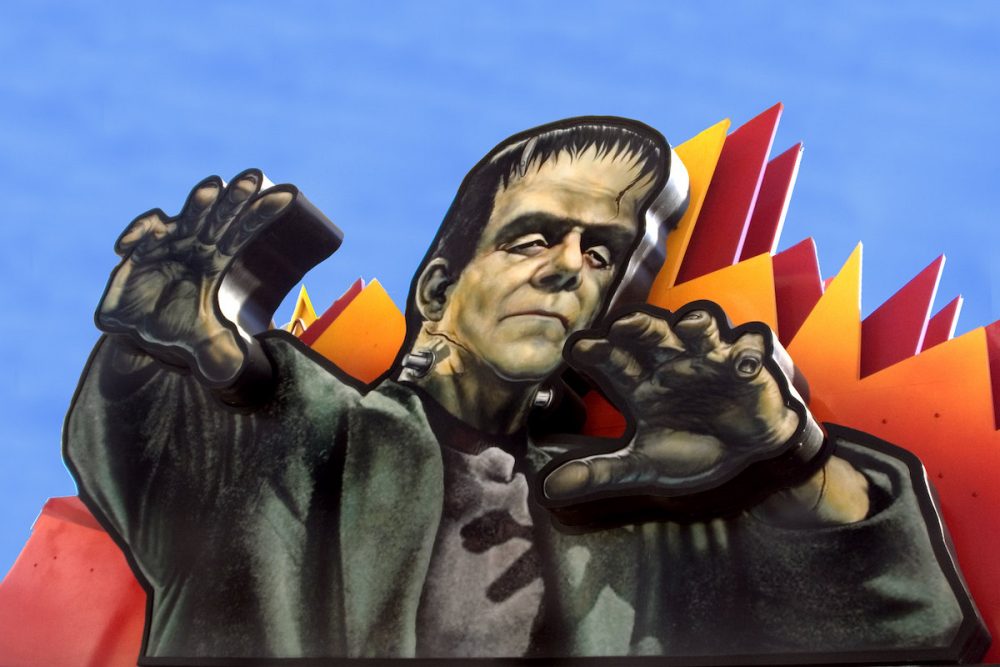
Today’s post is by author Catherine Baab-Muguira (@CatBaabMuguira).
Mary Shelley’s Frankenstein remains an undisputed classic. It’s required reading in classrooms across the world, while artists, writers and filmmakers constantly reinterpret its man-makes-monster premise. The longer you look, in fact, the more extraordinary its success becomes.
First published in 1818, Frankenstein was released in a modest edition of just 500 copies. Some 200 years later, in 2021, a first edition sold at auction for $1.2 million, setting a new record for a book by a female author. Thomas Edison, Mel Brooks and Tim Burton all adapted Frankenstein for the screen, with the total number of film adaptations now well into triple digits. Fresh off the success of Pan’s Labyrinth, Guillermo Del Toro began pre-production on his own adaptation in the 2010s—his dream project, he said—only to have it killed by the studio. A huge Frankenstein mask still hangs in the entrance to his L.A. home.
There are Frankenstein-inspired dolls for sale at Build-a-Bear. Frankenstein Legos. There’s even a breakfast cereal you can buy seasonally at Target—General Mills’ Frankenberry. Any 19th century novel inspiring this many interpretations is a wonder. But maybe most enviable are the book’s “backlist” sales. As the Guardian reports, Frankenstein still moves an eye-watering 40,000 copies a year, which means it outsells 99% of all “frontlist” (or newly released) titles.
Authors dream of such long-term success. But how to pull it off? Is Frankenstein a freak, or can it show us how to make art that lasts?
“Write a classic” isn’t a strategy, obviously. It’s a goal, plus a highly contingent outcome. No one could recreate the conditions that gave life to Frankenstein—its famous origin story is itself a series of unlikely contingencies. In 1815, Indonesia’s Mount Tambor volcano exploded in the largest, most powerful eruption ever recorded. With so much ash still in the atmosphere, the summer nights of 1816 were gloomier than anyone could remember. It became known as the “year without a summer.”
Mary Shelley, then 18 years old, happened to be staying in a Swiss villa with her lover Percy Bysshe Shelley, next door to the poet Lord Byron and other literary friends. To entertain themselves in the evenings, they told ghost stories, and in the grand tradition of writers everywhere, tried to outdo each other. Later, Mary Shelley would claim a certain monstrous face and form came to her in a waking dream. Two years and three drafts later, Frankenstein was published, though Shelley, fearing scandal, didn’t put her name on it. Instead, the book was published anonymously, which meant that—notwithstanding differences in copyright law then and now—its premise could essentially be pirated in stage plays and elsewhere without attribution.
The novel caught on quickly in part for such perverse reasons. To explain its staying power, however, we have to look further, seeing how Shelley’s novel demonstrates timeless truths about “perennial sellers,” to use Ryan Holiday’s phrase. As he argues in Perennial Seller, “the more important and perennial a problem” that a book concerns, the better the chances it will survive the test of time.
Frankenstein practically bum-rushes the criteria. Its characters’ problems are timeless. Victor Frankenstein, a starry-eyed scientist, is blinded by ambition, leading him to an act of creation he comes to bitterly regret. Meanwhile the monster, like all of us, finds himself here, alive and breathing, without ever having been consulted. Stranded and alone, he craves love. Denied it, he plots revenge. Shelley’s shifting POV, which veers from creator to so-called monster, poses daunting questions: Don’t we all deserve love? If bad treatment creates bad actors, what is our moral responsibility to every person and creature around us?
Helping to make these questions extra sticky is how readers of all ages may identify with an abandoned, rejected child. Impressions from our early childhood stay with us, consciously or unconsciously. Since our parents’ love is key to our survival, all of us know what it is to need it—and far too many know what it means to get something rather less than what they’d hoped. When stories touch us on such universal fears and on longings so fundamental they virtually define our species, then they can survive beyond their own epoch, fascinating no less than an Edison or del Toro.
This is why a great premise tends to trump great prose. That’s not a bolt of lightning, insight-wise, though it’s true. Frankenstein proves “astonishingly adaptable,” says the literary biographer Richard Holmes. Adam Gopnik, in the New Yorker, made the same claim about H.G. Wells’ work, citing Wells’ “premises so simple and strong that they can sustain any amount of retelling.” Edgar Allan Poe’s stories, for the same reason, get retold and reimagined in every generation.
So the reasons for Frankenstein’s success include its quick initial spread and a story touching on our sheer worst fears. And now here’s where things get really interesting.
Per a phenomenon known as the Lindy Effect, books that survive tend to keep surviving, as Holiday points out. Nassim Taleb has advanced the same idea, arguing that the longer a work of art survives, the longer it will survive. Which means that Frankenstein’s survival has contributed to—and still contributes to—its survival.
Tautological? Sure. Absolutely. That’s the whole point. Art that lasts tends to keep lasting.
Less directly, the Lindy Effect also explains why, while aspiring writers simply want to get published, established writers often aim to backlist well. Writing one hit is hard enough. Now imagine trying to do it three or four times over. Almost no one can. Pros know the better, more practical plan is to try to create work that survives, that can sell year after year after year.
It’s reasonable to ask if this doesn’t set the bar too high. If your aim is simply to finish writing your book, period, ensuring its long-term survival may seem an impossibly steep climb. At the same time, what Frankenstein makes clear is how you may just want to go for broke—all the more so when you consider the differences between Shelley’s time and our own.
Getting a traditional publishing deal was hard enough in her day. In ours, it’s even harder. There are more spots, but far more people competing for those spots. Likewise, while the pool of readers is much vaster, with literacy rates so much higher, there’s far more competition for readers’ attention. Mary Shelley had sexism to fear, not Netflix; jury’s out on which one’s worse. Under such conditions, it makes sense to attempt your own masterpiece—to aim to create work that might endure rather than something so topical it won’t. If the odds are desperate, not to say impossible, why not try to write books that are, per the Internet parlance, “very lindy”?
In other words, hitch your wagon to a star. Or maybe a misunderstood monster. Whatever works.

Catherine Baab-Muguira’s debut, Poe for Your Problems: Uncommon Advice from History’s Least Likely Self-Help Guru, was published by Hachette in September 2021. She also writes a free email newsletter called Poe Can Save Your Life, packed with darkly inspiring self-help tips for writers and other creatives. Check it out here.

“while aspiring writers simply want to get published, established writers often aim to backlist well.”
Such an important point, I think, it can’t be overstated. A backlist bestseller can provide an author with “passive income.” Publishers need titles that backlist well and consider it in the acquisition process. Solid backlist keeps a publisher operating.
And especially so when the publisher *is* the author.
You’re both right, and I agree. It’s like writing yourself an annuity. Or that’s the goal, anyway. 🙂
Well said! I think this applies to other mediums as well…film, music, food, etc. A classic is a classic as Coke learned so many years ago.
Thanks, Denise, and I totally agree. The same qualities that make other types of art last help a piece of writing to last. I only wish there were more books ON this subject!
What a great piece – and YES. One of my favourite books, Daphne du Maurier’s ‘Rebecca’ was written in 1938 and hasn’t gone out of print since. Every few years I re-read and still find it fresh and depressingly well written. She also manages to never reveal/use the heroine’s first name, just an aside. Thank you Cat for yet another original, intelligent viewpoint.
Thanks so much, Sue. I love Rebecca, too–and I’ve looked up the stats on it before with an eye to writing a newsletter post. It sells around 4,000 copies A MONTH, still. Another perennial seller, and for good reason… I really admire that novel and West more generally.